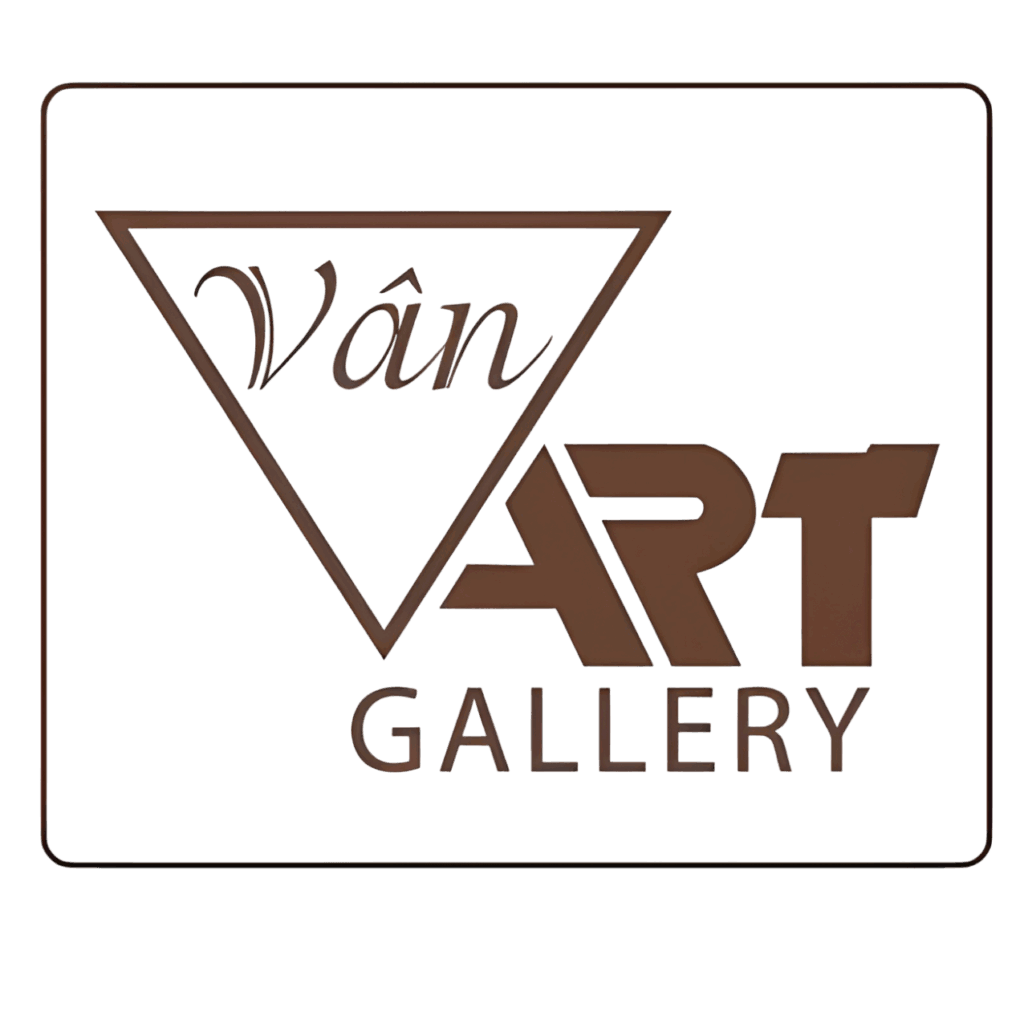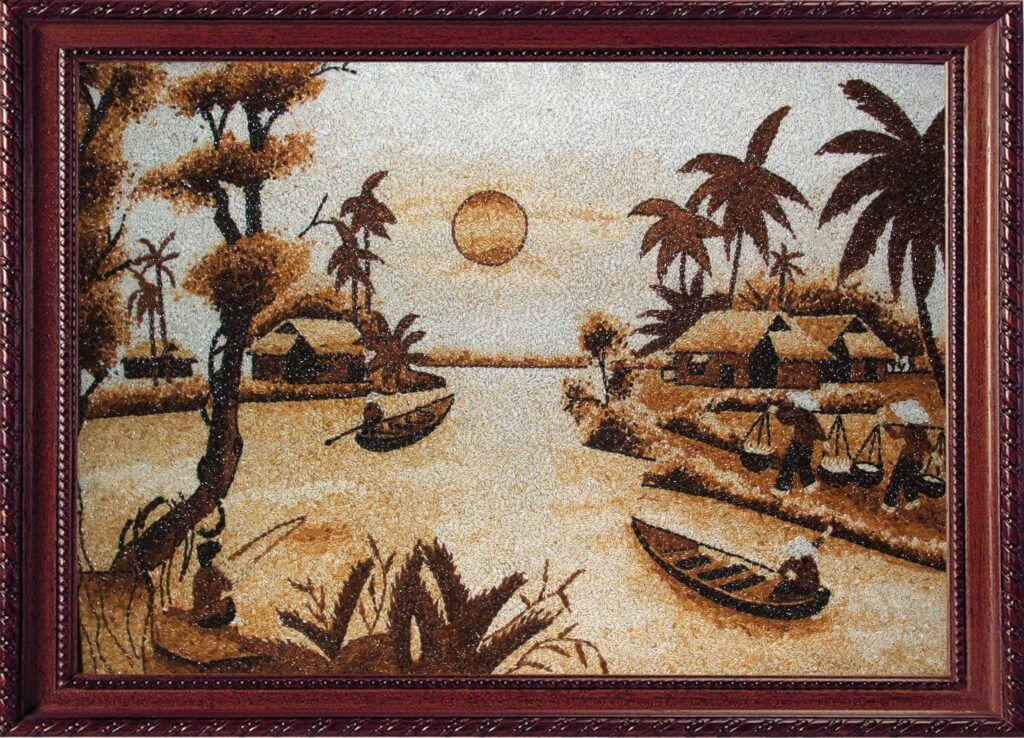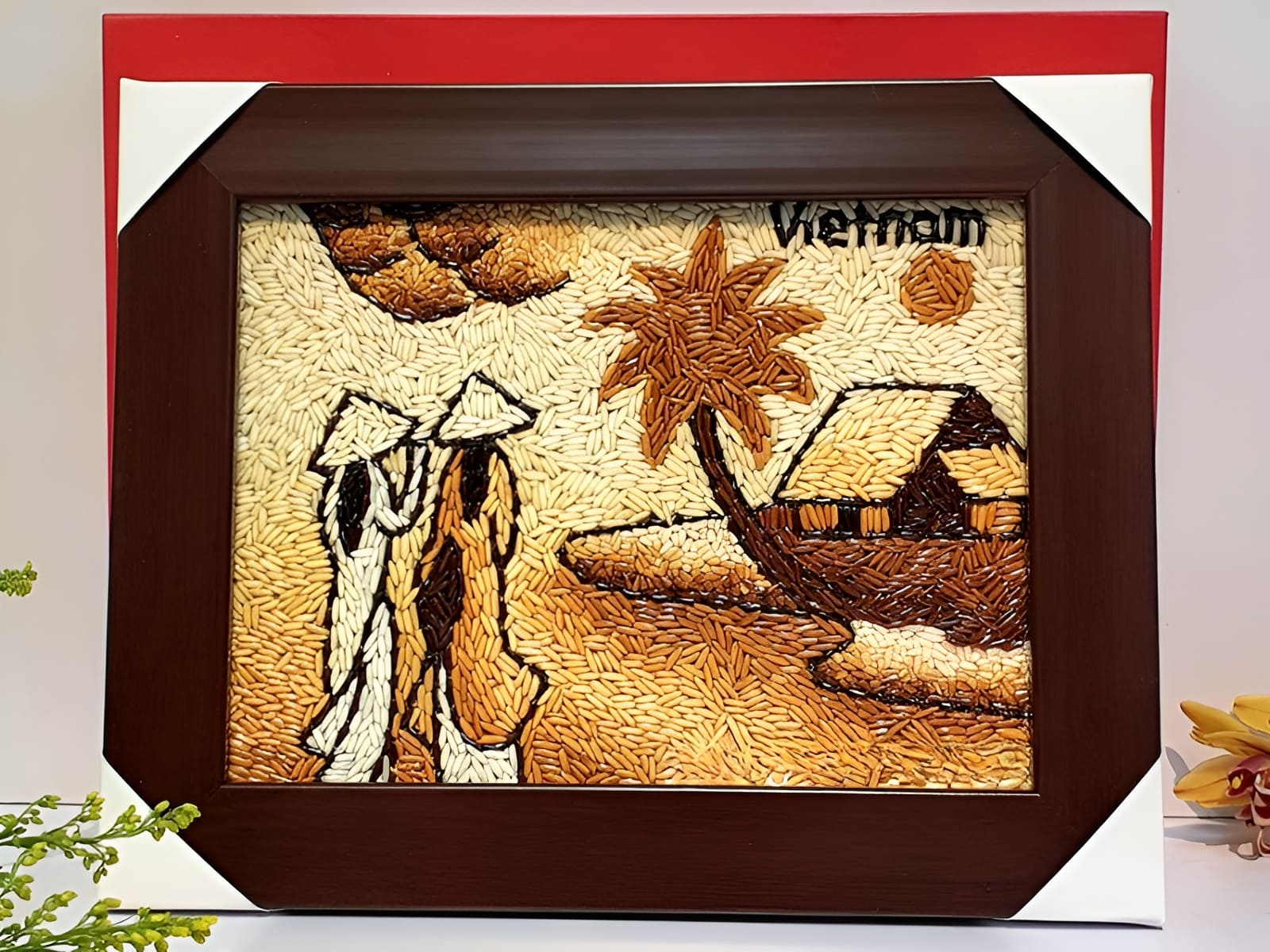Rice painting, a symbol of Vietnam’s rustic charm and national spirit, transforms humble rice grains into vibrant works of art. If you’re seeking a creative, meaningful, and accessible art form for home decor or gifting, rice painting is the perfect choice, often showcased in Hanoi art galleries. Rooted in Vietnam’s rice fields, this art not only beautifies spaces but also evokes deep cultural connections. This article guides you through what rice painting is, its profound significance, and a detailed step-by-step process to create your own masterpiece from hometown grains.
What Is Rice Painting? Introducing Vietnam’s Unique Folk Art
Rice painting is a Vietnamese folk art that uses rice grains as the primary medium to craft vivid images on wood or fabric, combining meticulous roasting and arrangement techniques. Unlike oil or silk paintings, rice painting exudes simplicity and relatability, reflecting rural life and the labor of Vietnamese farmers.
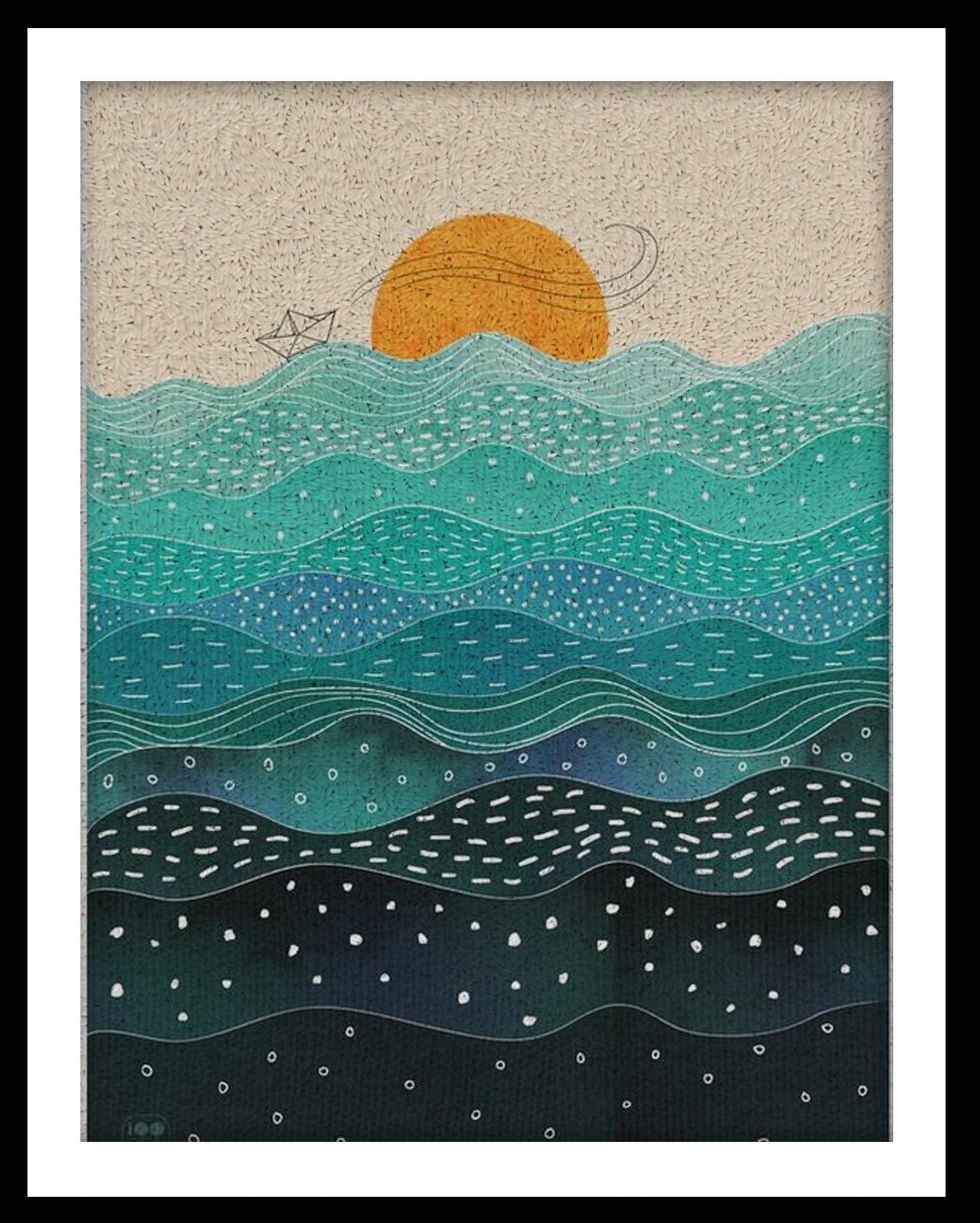
Origins and Characteristics of Vietnamese Rice Painting
Vietnamese rice painting originated in northern craft villages like Soc Son (Hanoi) and Bac Ninh, where artisans transform rice – a symbol of prosperity – into art. Gaining popularity since the 2000s, it blends tradition with modern creativity.
-
Main Materials: Sticky rice (for large areas), regular rice (fine details), and red dragon rice (for red accents) – roasted naturally to achieve 20-27 color shades from white to black, chemical-free.
-
Base: Wood panels (3-5mm thick) with sketched designs before rice application.
-
Characteristics: Natural colors, durable with proper treatment, mold-resistant, and available in sizes from small (20x30cm) to large (1x2m).
Vietnamese rice painting is more than a product; it’s a cultural narrative, often featured in folk exhibitions or as souvenirs.
How Rice Painting Differs from Other Art Forms
Compared to Dong Ho woodblock prints or silky paintings, rice painting stands out for its high craftsmanship, with each grain acting as a unique “brushstroke,” creating a subtle 3D effect. It’s more color-durable than paper art, ideal for long-term decor, and easily customizable for personal themes.
Significance of Rice Painting: A Symbol of Peace, Simplicity, and National Spirit
The significance of rice painting goes beyond aesthetics, tied to the rice grain – Vietnam’s lifeblood. Each artwork honors labor, evoking golden rice fields and family values.
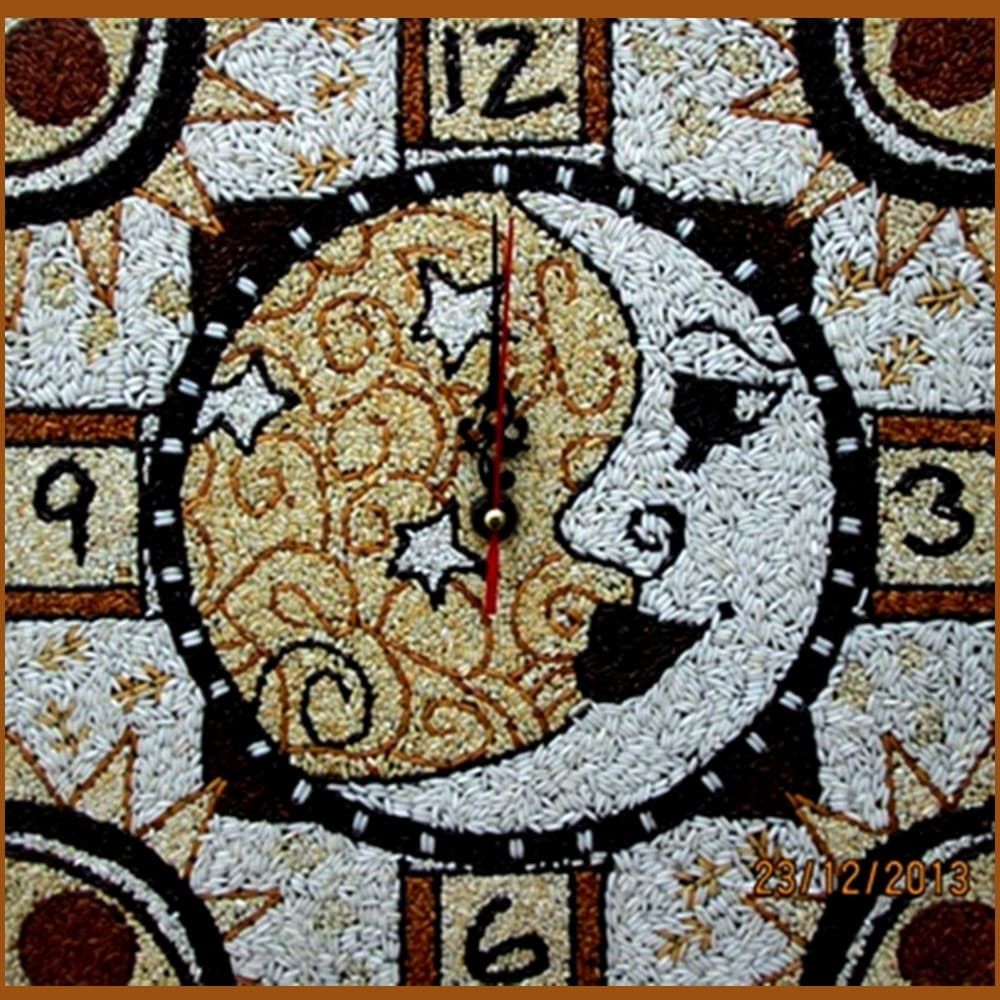
Cultural and Spiritual Value of Rice Painting
Rice painting embodies simplicity and perseverance, reflecting the proverb, “A father’s labor is as vast as Mount Thai Son, a mother’s love like an endless spring.” Artisans note that rice painting symbolizes abundance and peace, often used to wish for prosperity.
-
National Symbol: Rice represents Vietnam’s wet-rice agriculture, stirring hometown memories.
-
Spiritual Meaning: Themes like lotus flowers (purity) or landscapes (nature’s harmony) carry Buddhist and feng shui significance.
-
Modern Value: Perfect as corporate or family gifts, showcasing sincerity and uniqueness.
The significance of rice painting also lies in its creation process, teaching patience and making it a meaningful family activity.
Everyday Applications of Rice Painting
Rice painting isn’t just decor—it’s educational: hang it in living rooms to honor roots or gift it during Tet for blessings. Amid urbanization, rice painting bridges generations, bringing rural warmth to modern spaces.
How to Make Rice Painting: A Step-by-Step Guide for Beginners
Creating rice painting requires dexterity but is beginner-friendly, from roasting grains to arranging them. Here’s a 6-step guide based on traditional techniques.
Step 1: Prepare Materials and Roast Rice for Colors
Select clean, uniform rice grains. Roast over low heat to create natural colors, from white (short roast) to black (long roast).
-
Rice Selection: Clean sticky or regular rice, free of pests.
-
Roasting: Stir evenly for 30-120 minutes, depending on color (e.g., 30 minutes for light yellow, 2 hours for dark brown).
-
Tip: Use low heat to avoid popping; aim for 20-27 shades.
Step 2: Sketch the Design on a Wooden Base
Use a thin wood panel and sketch the design with a pencil or stencil.
-
Tools: 3-5mm wood panel, pencil, ruler.
-
Tip: Start with simple themes like lotus flowers for beginners.
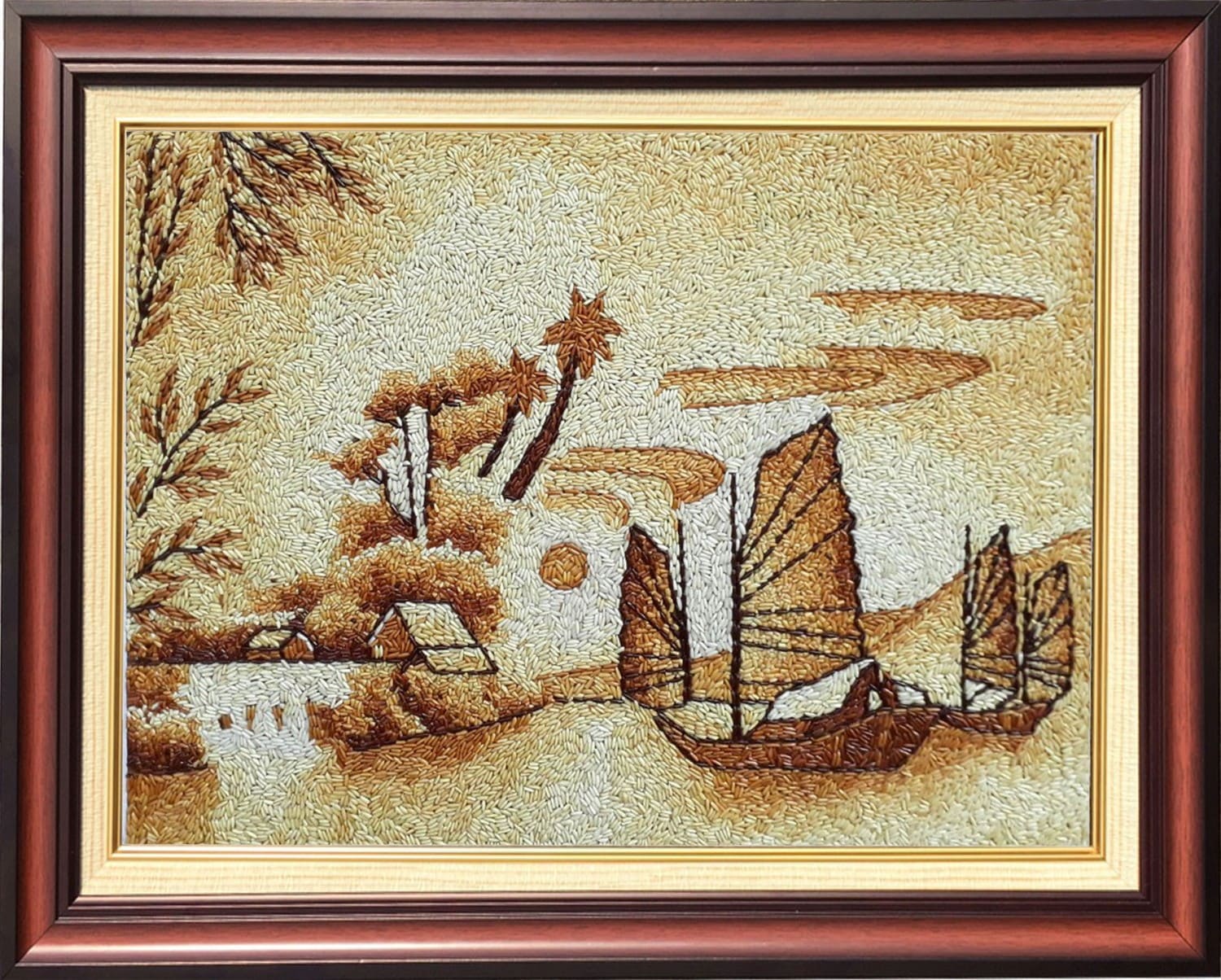
Step 3: Apply Glue and Arrange Rice Grains
Apply milk glue to sketched lines, using tweezers to place rice grains by color.
-
Technique: Start with large background areas, finishing with small details; adjust grains to match the design.
-
Aesthetics: Arrange evenly, using light/dark grains for shading effects.
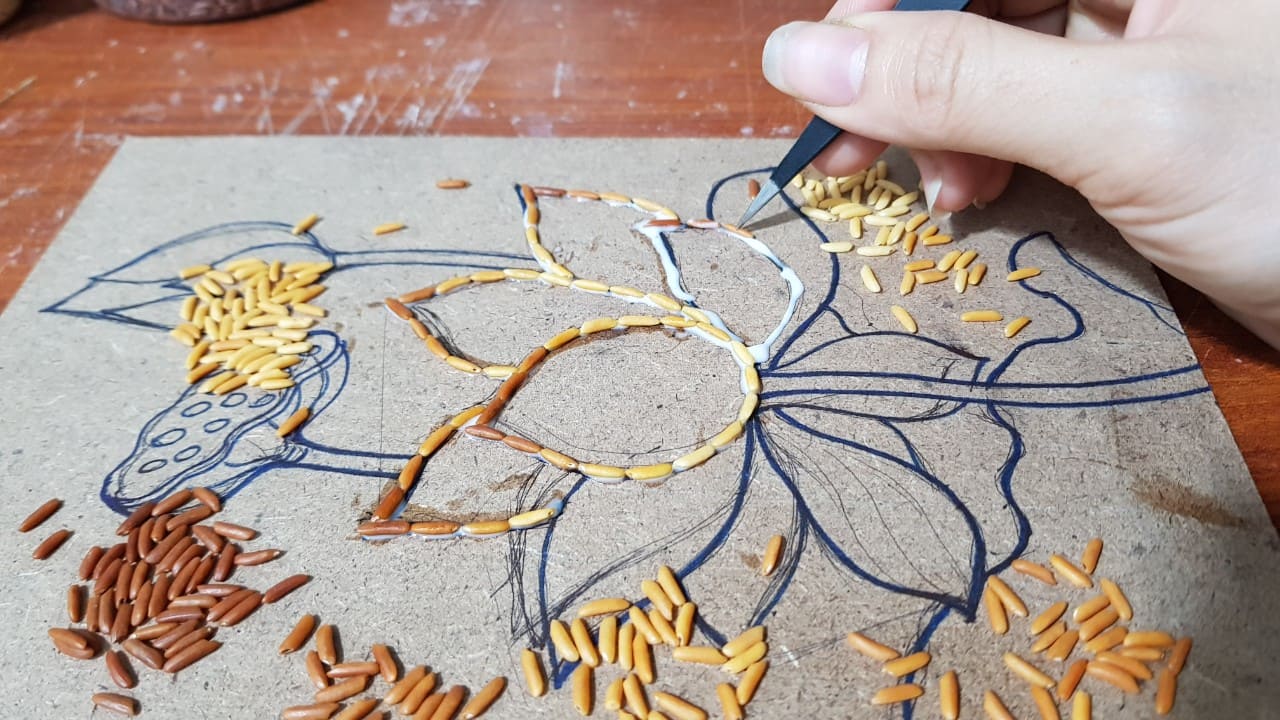
Step 4: Secure and Treat the Surface
Spray with 502 glue to fix grains, then apply a glossy varnish to prevent mold.
-
Gluing: Spray evenly, press lightly to secure grains.
-
Treatment: Add anti-termite chemicals and glossy varnish for vibrancy.
Step 5: Dry and Cure the Painting
Dry the painting in a hot oven or indirect sunlight for 2 days to set the glue.
-
Tip: Avoid direct sun to prevent fading; check adhesion.
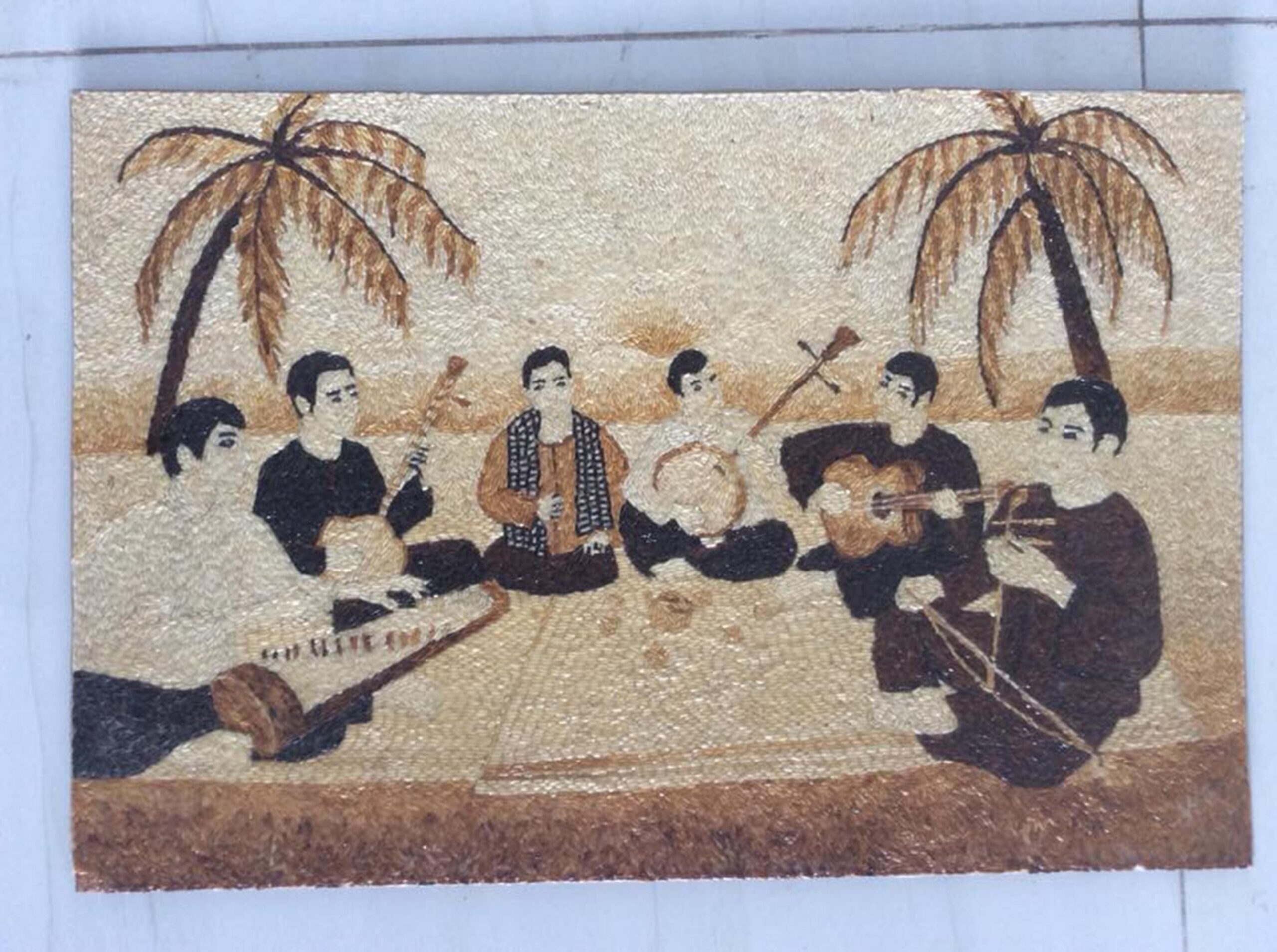
Step 6: Frame and Preserve the Rice Painting
Frame with wood or glass for completion, storing in a dry place.
-
Preservation: Dust regularly, expose to indirect sunlight every 1-2 months.
-
Beginner Tip: Start with a small 20x30cm painting.
Making rice painting at home takes 3-7 days, but the result—a unique masterpiece—is worth it.
Iconic Rice Painting Works: Masterpieces Full of Vietnamese Soul
Iconic rice painting works are not only beautiful but tell cultural stories, from elegant lotuses to majestic landscapes.
Lotus Rice Painting: Symbol of Purity and Peace
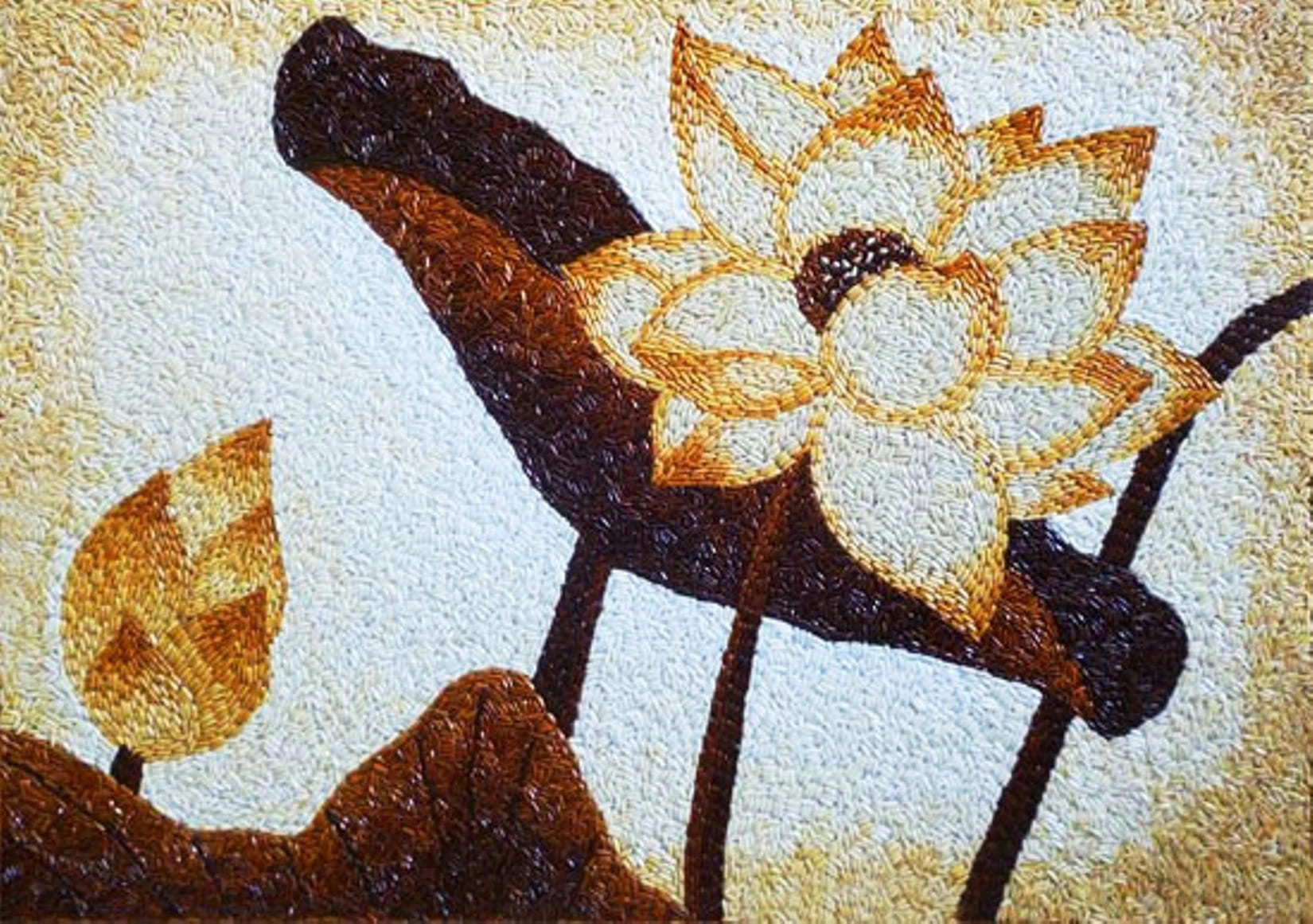
Lotus rice paintings depict flowers rising from mud, using white-green grains for vibrant leaves.
-
Features: Brown rice backgrounds with pristine white lotuses, symbolizing resilience.
-
Example: Soc Son artisan works, 50x70cm, priced at 5-10 million VND.
Landscape Rice Painting: Evoking Vietnamese Villages
Landscape rice paintings capture rice fields and rivers, using yellow-brown grains for golden fields.
-
Themes: Mountains, Duong River, reminiscent of Dong Ho prints.
-
Value: Ideal for living rooms, bringing rural tranquility.
Portrait Rice Painting: Refined and Personalized
Portrait rice paintings use fine grains for expressive faces, adding emotional depth.
-
Applications: Family portraits or Ho Chi Minh images, popular for holidays.
-
Example: Leader portraits, priced at 10-20 million VND.
Iconic rice painting works often appear at craft village exhibitions, proving the vitality of folk art.
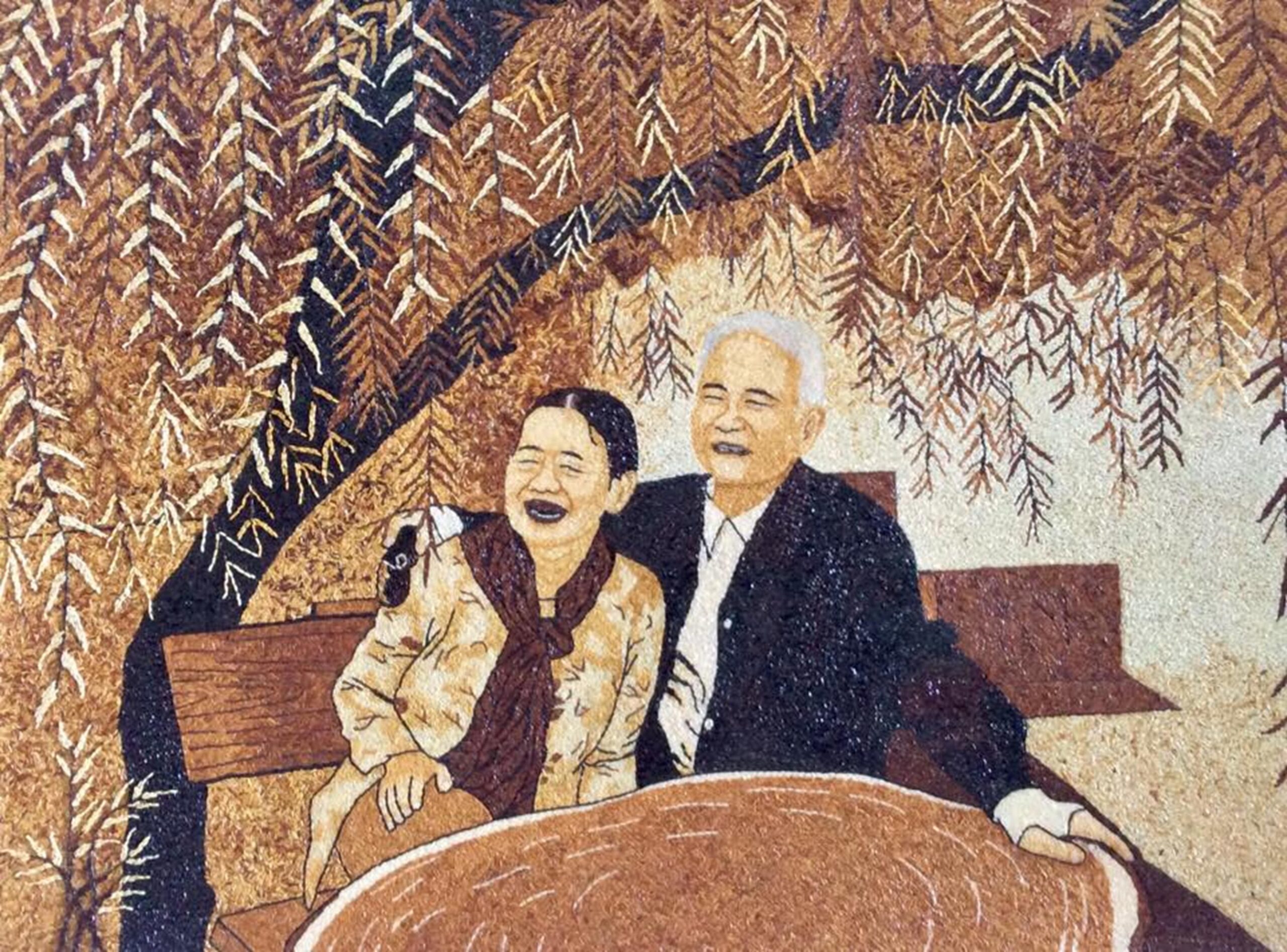
Uses and Preservation of Rice Painting: Tips for Longevity
Rice painting serves as both decor and meaningful gifts, with versatile applications from homes to events.
Using Rice Painting for Decor and Gifting
-
Decor: Hang in living rooms facing east for feng shui luck.
-
Gifts: Custom portraits (2-5 million VND), more meaningful than printed art.
-
Events: Showcased at exhibitions or fairs like Hanoi’s Green Market.
Tips for Preserving Rice Painting
-
Environment: Store in dry, airy spaces at 20-25°C to avoid mold.
-
Maintenance: Dust with a soft cloth; expose to indirect sunlight every 1-2 months.
-
Treatment: Use specialized chemicals if termites appear.
With proper care, rice paintings can last 20-50 years, preserving their cultural value.
Conclusion: Rice Painting – Vietnam’s Rustic Soul
Rice painting is more than art—it’s Vietnam’s essence, simple yet profound. Try crafting a piece to experience the journey from humble grains to timeless masterpieces! Share your favorite rice painting theme in the comments below!
